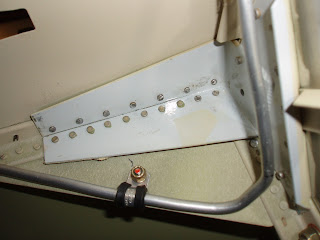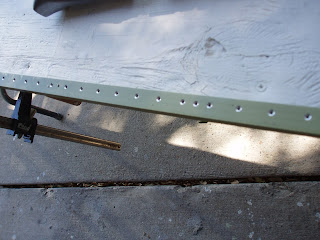a. Vans Aircraft Assembly Manual, Section 8, Firewall, Firewall Forward Installation
b. Van's Aircraft Manual, Section 5: General Information
c. Standard Aircraft Handbook (Larry Reithmaier), 1999
d. Drawing 19 Firewall
We included assembly of the firewall and attachment of the engine mount in the firewall forward segment.
Holes for reinforcement angles and corner fittings are made per drawing 19, as are holes for throttle and mixture cables, cabin heater inlet and nose gear access hole
I like using a drill guide for critical, but there were no instructions in the Van's manual to achieve this. We machined six (6) of them for the engine mount to firewall/fuselage attachment bolts,
starting with a 3/16 drill,
until finally the final size was reamed for the 3/8 holes for the AN6-24 bolts (3/8-24 bolts), (firewall side shown).
and from cockpit side:
To align the Attachment bolts (3/8-24) were torqued to the low limit for this nut (160 in. lbs.) or as high as 190 in. lbs. as required to line-up the cotter pin hole.
Once the actual firewall is installed , the rest of firewall forward is quite simple and mostly described by drawings 31A, 46A, OP-26, OP-32, OP-33, . Noteworthy procedures included installation of fittings into the engine, such as the 45-degree angle fitting for the cockpit oil pressure gage and the the two oil cooler line fitting installed on the engine accessory case. Both are wet-installed using Permatex high temperature thread sealant. All cable passages through the firewall were made using interlocking flanged sleeves, one installed from cockpit side and one from engine side and sealed with AMS-S-8802 high adhesion fuel tank sealant . All cables and hoses were covered with insulation sleeving.
The IO-360-M1B was attached to the engine mount using the Dynafocal Mounting Kit per drawing 46A. Of note is that the bolts are tightened to bottom out on the mount spacers, then torqued to standard AN7 value (450 to 500 in-lbs) using a crowfoot wrench.
Fitting the snorkel to the fuel injection servo:
and inlet filter hole:
and fitting the cowls to fit over the air seal fabric
Proper fit has since been confirmed by bringing engine to normal running temperature to allow for air seal fabric to conform to inside cowl surfaces.


















































